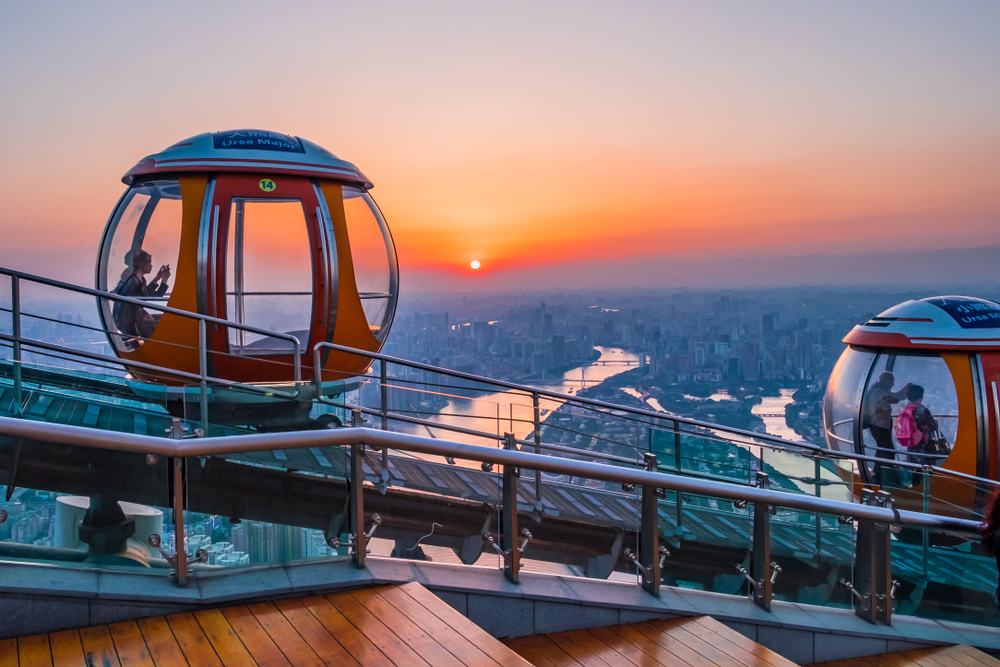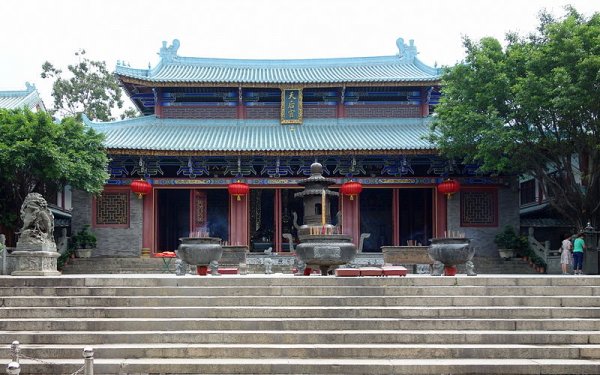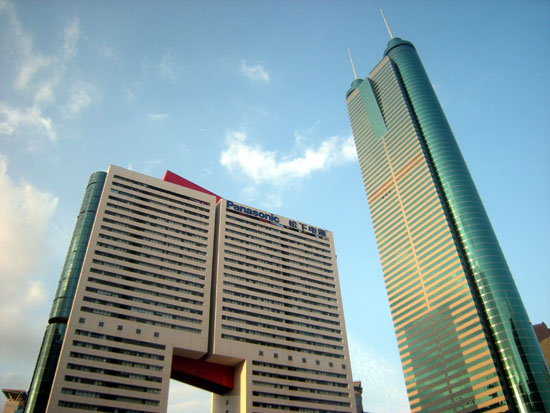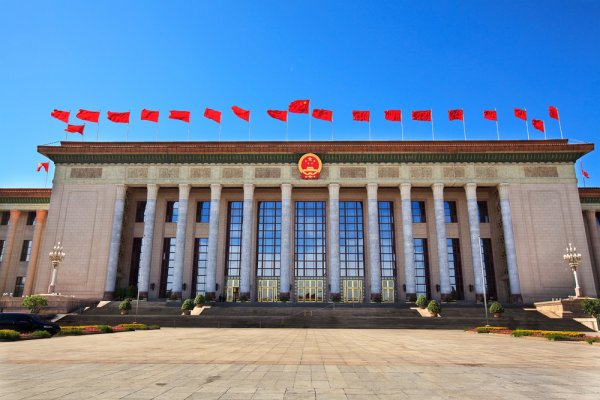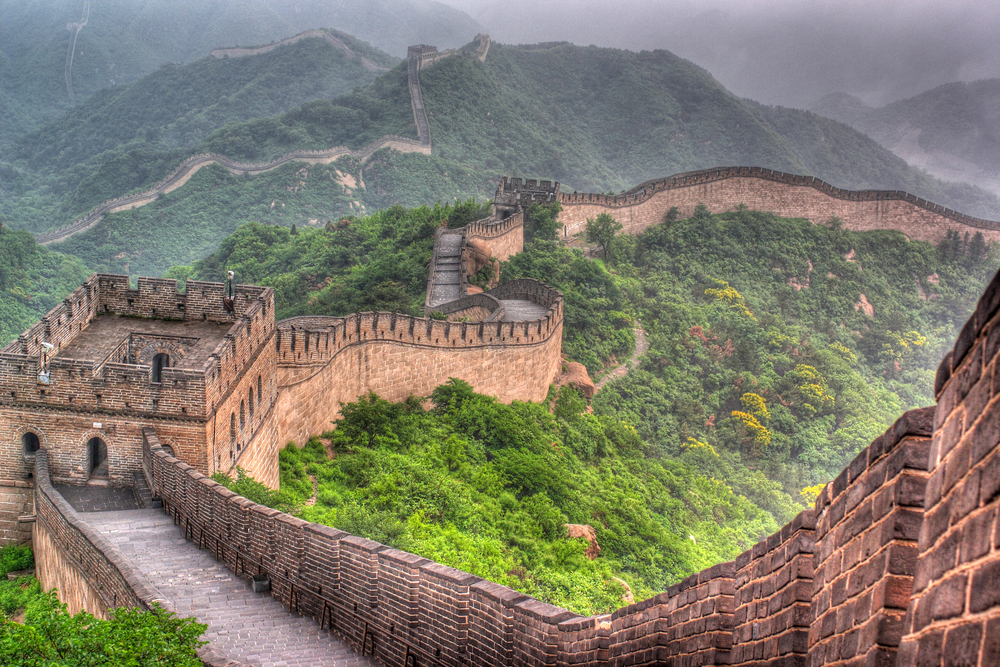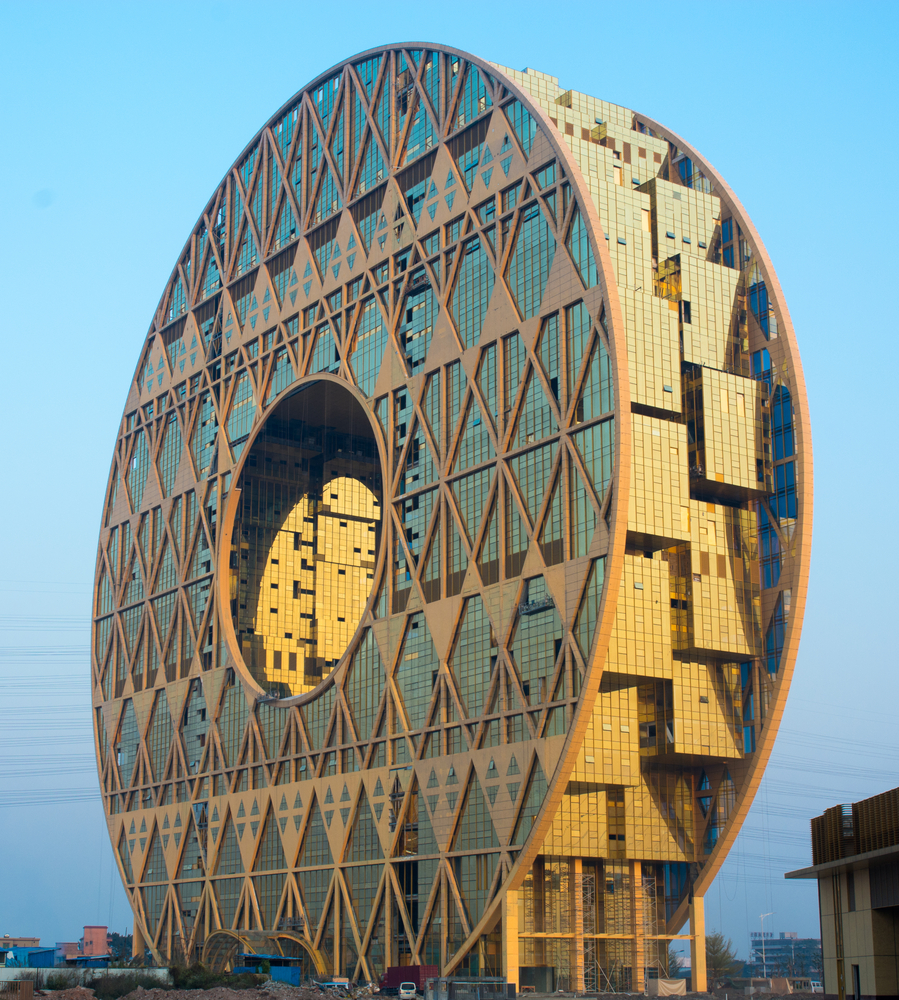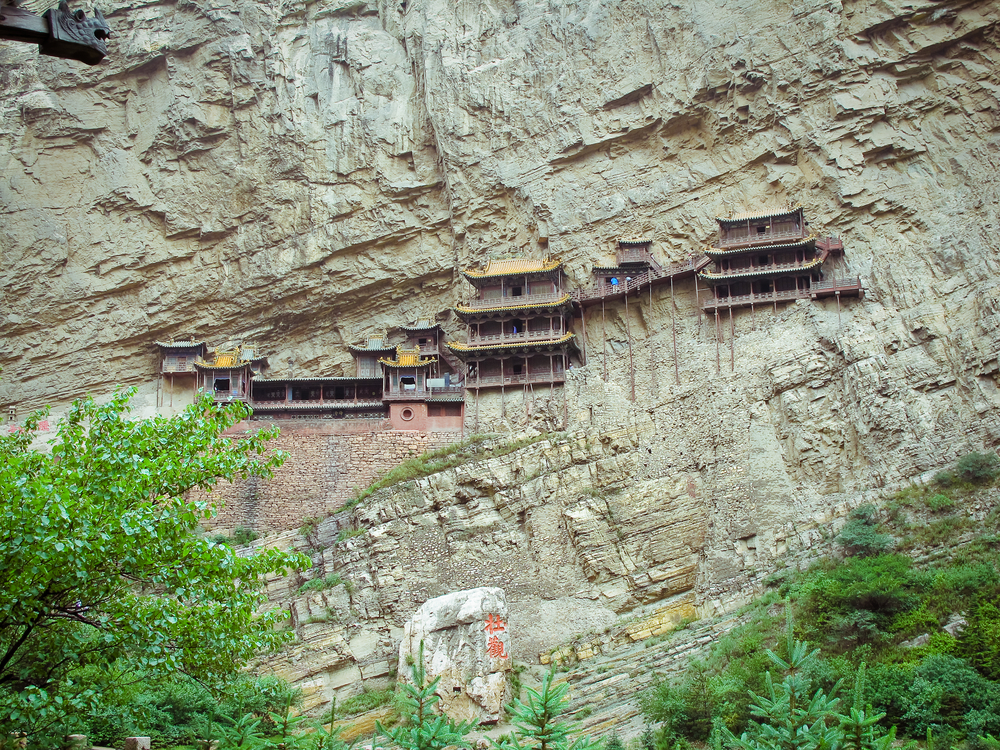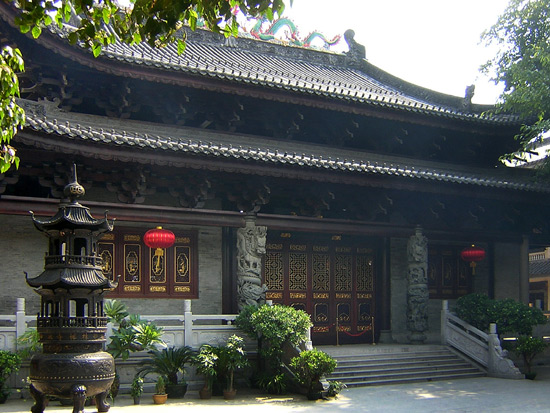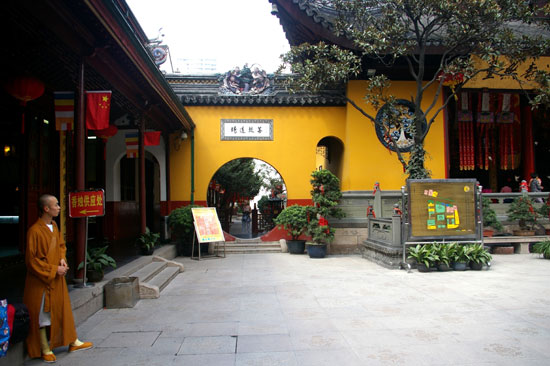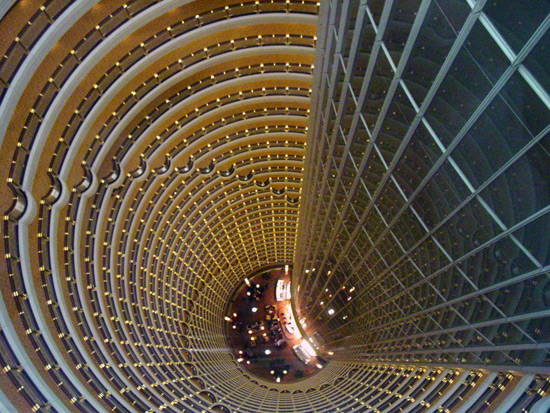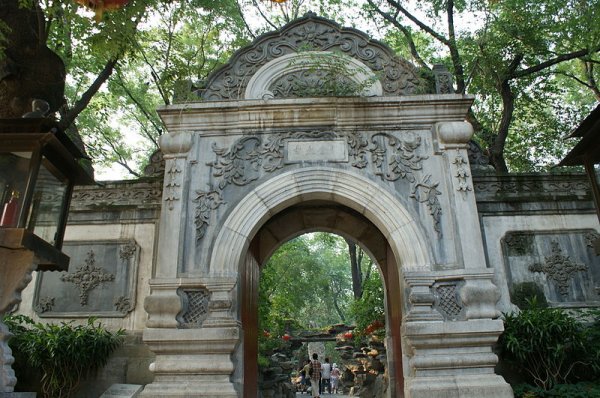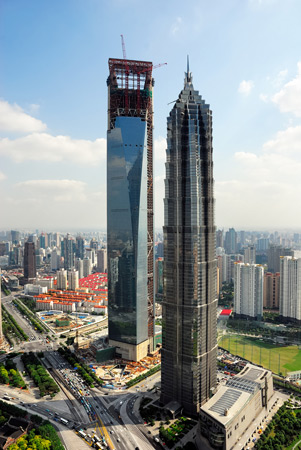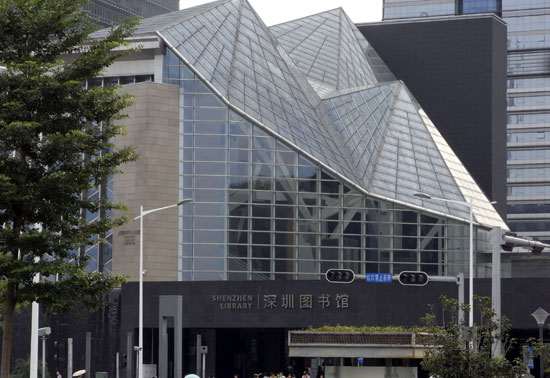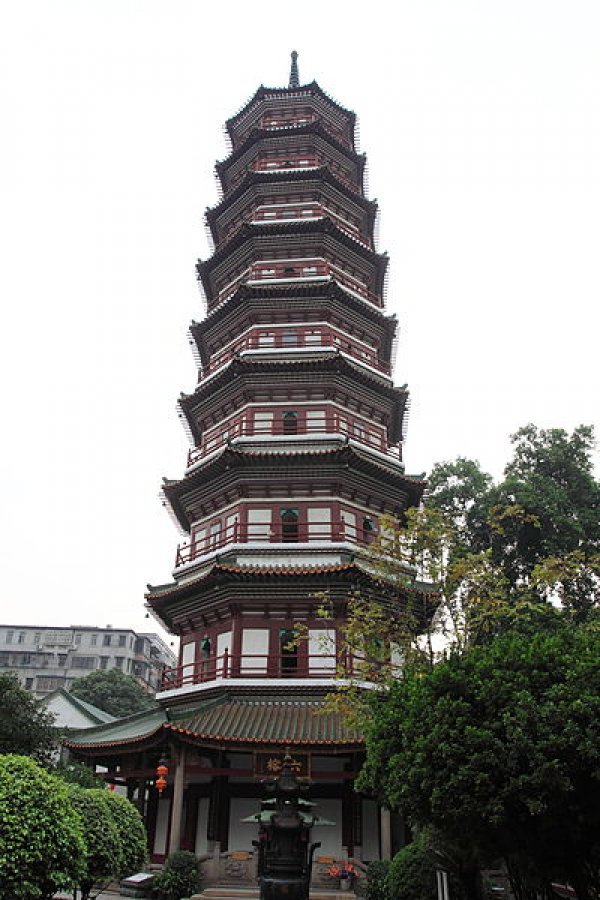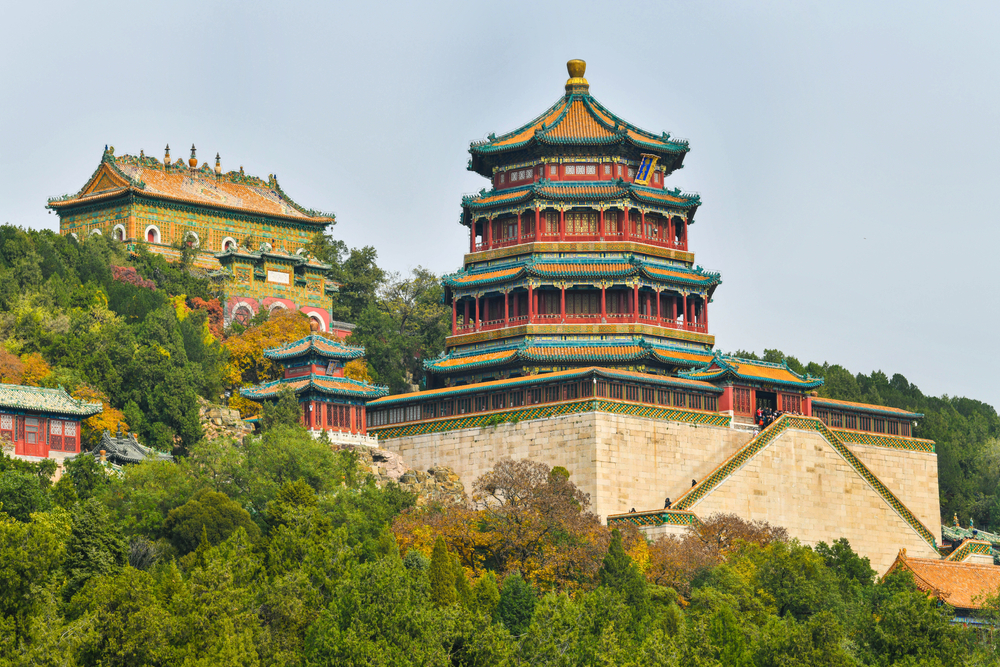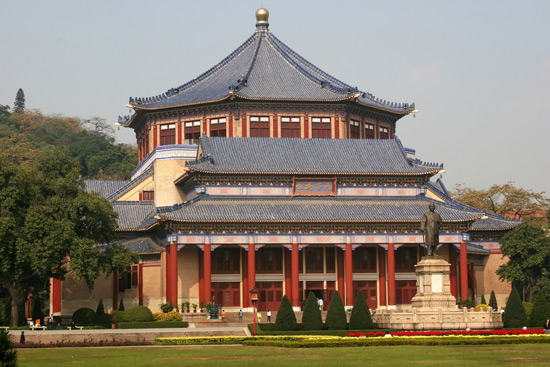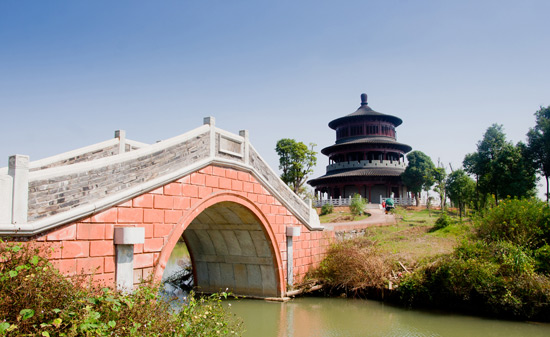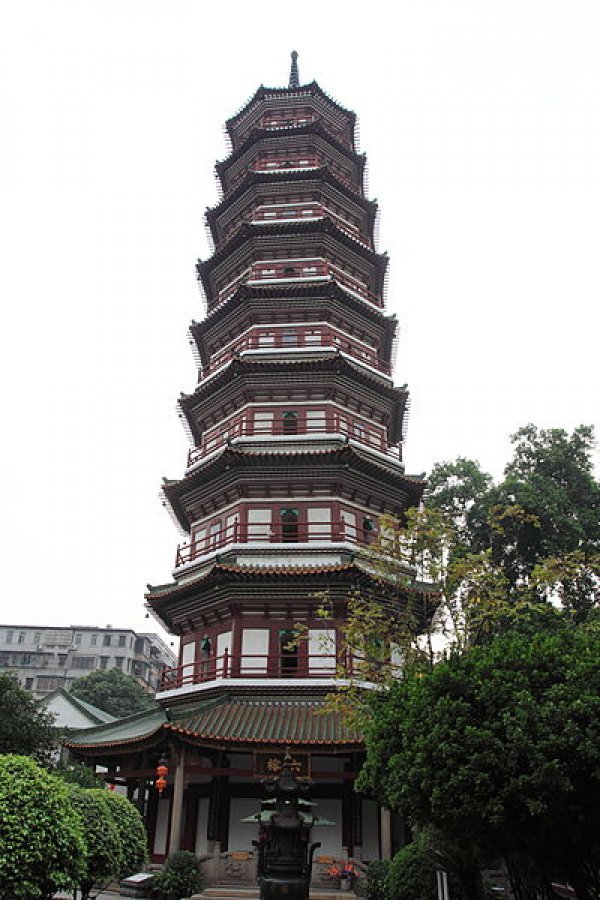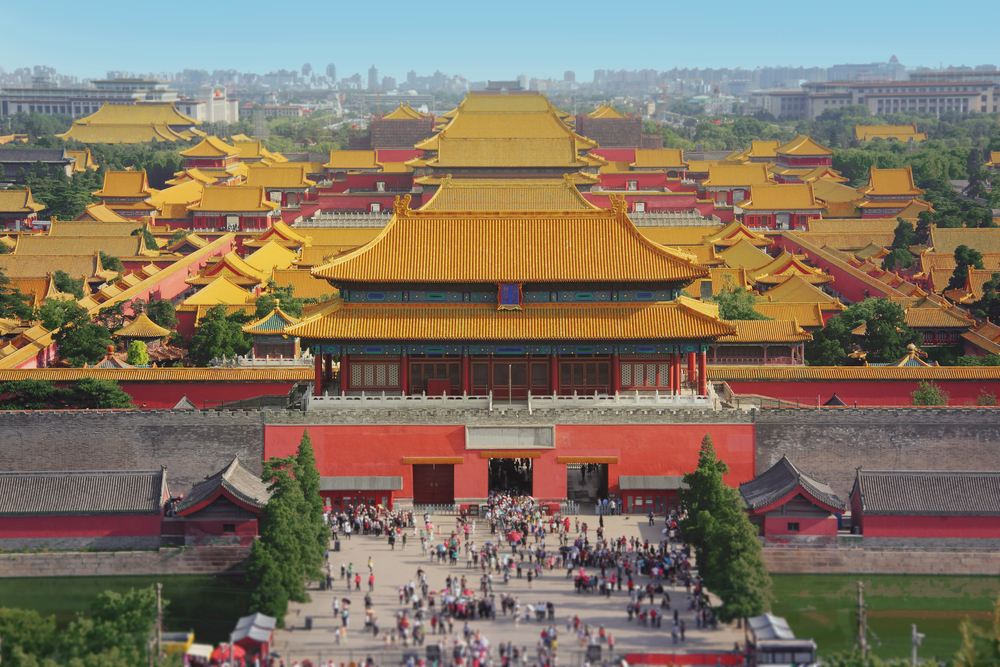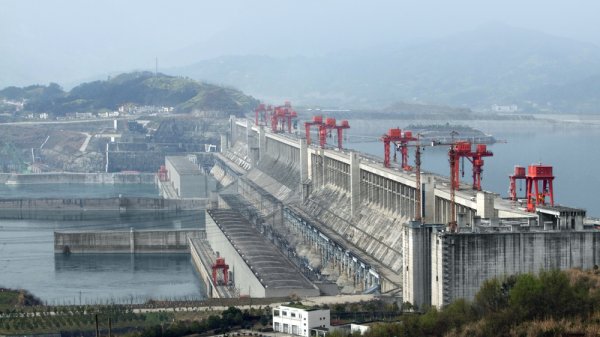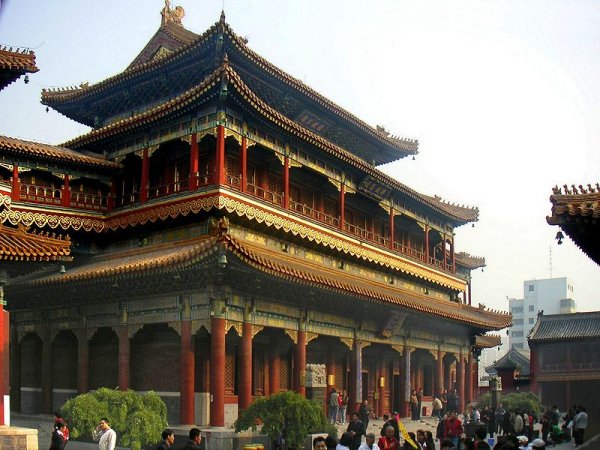Points of Interest
Bell Tower and Drum Tower
North End of Dianmenwai Street
Beijing, China
The Bell Tower (Zhonglou) was built during the reign of emperor Yongle and the Drum Tower (Gulou) in 1272. Both stand very close to each other and were built primarily for musical reasons. During the Yuan, Ming, and Qing dynasties, however, they were used to tell the time. The Drum Tower is a two-story, 47-meter-tall (154-foot-tall) wooden building that originally housed 24 drums, of which only one survives today. The Bell Tower is a 50-meter-high (164-foot-high) stone and brick edifice with a green glazed roof and gray walls. Its bell weighs 63 tons, making it the biggest ancient bell in China.
Canton Tower
222 Yuejiangxi Road
Haizhu District, Guangzhou, China
Also known as Guangzhou Tower, this 604-meter-tall (1,982-foot-tall) observation tower overlooks the Pearl River in Guangzhou’s Haizhu District. It offers several observation decks and thrilling adventures. The tower’s vertical freefall ride called Sky Drop is recognized by Guinness World Records as the world’s highest thrill ride. Riders can choose to freefall sitting or standing from about 455–485 meters (1,493–1,591 feet) high. A little more relaxing, the Bubble Tram features 16 spherical cabins that can each take up to six people on a 20-minute ride along a track high above the city. At a height of 488 meters (1,601 feet), an outdoor lookout provides 360-degree views of Guangzhou. The tower also has options for shopping and dining.
Chiwan Tian Hou Temple
Sekou Nanshan District Chiwan
Shenzhen, China
This temple dedicated to the worship of Tian Hou, the Chinese goddess of the sea, is one of the oldest religious sites in Shenzhen. Sitting atop a hill above Nanshan Peninsula, overlooking Shenzhen Bay, the temple dates to the early 1400s, although there has purportedly been some kind of temple on the site since sometime in the Southern Song Dynasty (1127–1279 CE). Typically Chinese upturned roof corners on its two-tiered buildings characterize the temple, although many of the structures feel more modern, having been constructed of stone rather than wood. There are also two small, murky pools at one corner of the grounds, which flank a bronze statue of Tian Hou herself. Though certainly not the grandest temple in China, this shrine makes for a convenient look into the history and religious traditions of the people of the Shenzhen region.
Diwang Mansion
Shennan Road at Bao'an South Road
Luohu District
Shenzhen, China
Shenzhen is known for its growing skyline, which is topped out by this massive skyscraper, one of the tallest in the city. The 69th floor of Diwang Mansion is home to the Meridian View Centre, an observation platform that provides a 360-degree panorama over Shenzhen. On a clear day (which are admittedly rare here), you can see across the length of the border and out to Hong Kong's verdant New Territories, as well as into Shenzhen Bay. The lower floors of Diwang Mansion are comprised of Shun Hing Square, a shopping mall with all of the typical stores and a food court that provide a nice respite from the many other sights and shopping in the Luohu District. Full price tickets cost ¥30 and include a speedy elevator ride up to the Meridian View Centre.
Great Hall of the People
Beijing, China
The Great Hall of the People is a parliament building that stands at the western edge of the Tian'anmen Square. Mainly used for ceremonial and legislative activities, it was built in 1959 in just 10 months. The building consists of three parts, namely central, northern, and southern sections, and covers an area of 171,800 square meters (1,849,240 square feet). Each province has its own hall (like Hong Kong Hall, Taiwan Hall) that contains architectural designs and interiors that reflect the region's unique characteristics. In addition, it houses the Standing Committee of the People's Congress of China. The Great Auditorium, where most of the activity takes place, can seat 10,000 people at a time.
Great Wall of China
Shanhai Pass in the east to Lop Nur in the west
China
The Great Wall of China is a series of fortifications made from earth, brick, and stone. It was built and rebuilt many times from the 5th and 6th centuries BCE to the 16th century CE, to protect the northern borders of the Chinese empire. With a length of more than 6,437 kilometers (4,000 miles), the Great Wall of China is the longest manmade structure in the world. The wall has a series of towers located at regular intervals and runs roughly along Mongolia's southern border. It remains one of China's major tourist attractions.
Guangzhou Circle
Guangzhouyuan Road
Liwan District
Guangzhou, China
Completed in 2013, Guangzhou Circle is a 138-meter-tall (453-foot-tall) doughnut-shaped building, the tallest building of its shape. Designed by Italian architect Joseph di Pasquale, it houses Hongda Xingye Group and Guangdong Plastic Exchange, the world’s largest trading center for raw plastics. The building’s shape resembles an ancient Chinese coin, although Pasquale has only said that he was inspired by “the Chinese way of perceiving and understanding” when designing it. The structure itself as well as many of its elements are symbols related to Chinese history and culture.
Hanging Temple
Mount Heng
Shanxi, China
The Hanging Temple is a Buddhist temple built into the west cliff of the Jinxia Gorge, at the foot of Mount Heng. Built in 491, the Hanging monastery is an architectural wonder that blends a unique mechanical theory with aesthetics. It is a very big temple, with 40 cabinets and halls that contain about 80 sculptures made of stone, iron, copper, and terracotta. Due to its unique location, the temple is protected from the damage caused by rain, snow, and sunlight. Another reason for its unique location is that it helps maintain an important Taoist belief, absolute quietness.
Hualin Temple
31 Shangxiajiu
Guangzhou, China
This rather underappreciated gem of an ancient Buddhist temple sits in the middle of the busy Hualin Jade Street market. Built sometime during the Southern Dynasties period, the ancient temple has stood here for around 1,400 years. Expanded during the 1600s, it was officially renamed Hualin. The interior of the temple features a wonderful collection of golden statues of arhats (enlightened entities of Buddhism), each with its own delightfully unique facial expression and body language. A statue of famed explorer Marco Polo stands at one end of the room, and the treasured white dolomite dagoba that stands outside is said to house relics of the Buddha.
Jade Buddha Temple
170 Anyuan Road
Shanghai, China
Jade Buddha Temple was founded in 1882 with two jade Buddha statues brought from Burma. These original two are a sitting Buddha statue that is 2 meters (6.5 feet) tall and weighs 3 tons; and a smaller reclining Buddha. The temple is a reflection of both the Chan and Pure Land traditions of Mahayana Buddhism. At present, the temple consists of two main halls, the Chamber of Four Heavenly Kings and the Grand Hall (or Great Hall), which contain a number of statues. The temple is also home to the Shanghai Institute of Buddhism.
Jinlun Guild Hall
289 Kangwang South Lu
Guangzhou, China
This lesser-known temple is small and mostly empty but rife with history, making it an interesting quick stop on a walking tour of the Liwan District. Constructed in 1723, this is the last of what was once a large collection of guildhalls in Guangzhou. Built in the style of an ancestral temple, this guildhall served as the main offices for the silk traders' association during the Qing Dynasty. The hall today exhibits only a few silk embroideries and some dusty paintings for sale, but fascinates as a well preserved historic and architectural gem. Interestingly, in 2001, the entire hall was disassembled and carefully reconstructed 80 meters (262 feet) north of its original location to make way for a new street.
Jinmao Tower
88 Shiji Da Dao Pudong
Shanghai, China
At 420.5 meters (1,378 feet) high, Jinmao Tower is one of the world's tallest buildings. Its tiered shape resembling a Chinese pagoda is another staple along the Pudong skyline. Inside the Jinmao Tower are offices, Shanghai Grand Hyatt, and Skywalk, a viewing platform on the 88th floor. The number 8 is considered lucky in Chinese culture, so it is no accident that this tower is saturated with that digit. A shiny elevator whisks visitors to the top in a matter of seconds, where they are greeted by tall windows framing a vertigo-inducing view. A number of restaurants and nightclubs are dotted along several floors of the tower as well.
Nansha Tianhou Palace
Dajia Hill Nánshā
Guangzhou, China
This sprawling palace complex resembling the Forbidden City in Beijing honors the ancient sea goddess whose foreboding statue stands in the entrance square. Erected during the Ming Dynasty, the palace features a series of courtyards and halls designed to worship the goddess, who, according to legend, died while trying to save someone from drowning. Numerous effigies of the goddess fill the various ceremonial rooms, while the eight-story Nanling Tower rises up over the palace at the back of the grounds. The palace underwent renovations in 1994 and in 1996 and is one of the largest complexes of its kind in the world.
Prince Gong's Manor
A14 Liuyin Street
Xicheng District
Beijing, China
This elaborate historic home was built in 1777 for He Shen, an imperial official to Emperor Qianlong. Later, when He Shen was accused of corruption and executed, the mansion was confiscated and eventually given to a subsequent emperor's brother, Prince Gong. Though the grounds have been used for a variety of purposes over the years, from a Catholic university campus to an air-conditioning factory, today they have been restored to their early glory and are open to the public. Widely considered to be one of the most ornate palaces in Beijing, the grounds consist of several traditional courtyard buildings, open-air corridors, ponds, pavilions, and Suzhou-style gardens, as well as a Peking Opera house.
Shanghai World Financial Center
100 Century Avenue
Pudong
Shanghai, China
When it officially opened in 2008, this massive skyscraper was the tallest building in China and second tallest in the world at just over 488 meters (1,600 feet) tall with 101 stories. Often called the "bottle cap opener" because of its unique hollow-topped shape, the Shanghai World Financial Center has one of the world's highest observation decks, located on its 100th floor. Just above the building's hollow opening, this deck is made largely of glass, including several glass slats in the flooring, which offer views down to the 97th floor and out across Shanghai. Another viewing deck, on the 97th floor just below the hole, has glass ceilings, while the 94th floor houses a third viewing deck with a coffee shop and souvenir stores.
Shenzhen Library
2016 Fuzhong 1st Road
Futian District
Shenzhen, China
One of the architectural treasures of the city, Shenzhen Library boasts the type of innovative design that is making the city famous. Designed by Japanese architect Arata Isozaki (also known for the Museum of Contemporary Art in Los Angeles and the Kyoto Concert Hall in Japan) in combination with the Shenzhen Concert Hall, the library's most stiking element is its folded glass-front façade, which creates a naturally lit interior atrium. The library houses nearly 2.5 million books and periodicals, including many foreign-language titles. The Shenzhen Cultural Center, which contains the library and concert hall, is a must-visit spot, especially for architecture buffs.
Six Banyan Monastery
Liurong Road
Guangzhou, China
The Temple of Six-Banyan Trees is a Buddhist temple in Guangzhou that was built in 573 by the Liang Dynasty. During its 1,400-year history, it was rebuilt and renamed several times. The temple's pagoda, known variously as the Flowery Pagoda or Six Banyan Pagoda, was built in 1097 and is shaped like a flower, hence its name. The temple consists of three halls, the Tianwang Hall, which contains a statue of the Laughing Buddha; the Weituo Hall; and the main Daxiong Baodian Hall, which holds three huge ancient copper Buddhist statues. The temple hosts huge crowds during the Spring and Lantern festivals, when devotees burn incense to seek divine blessings.
Summer Palace
The Summer Palace
Hai Dian Qu, China
The Summer Palace is a palace dominated by the 60-meter-high (197 feet) Longevity Hill and Kunming Lake. The building, constructed in 1750, covers an area of 70,000 square meters and contains a variety of palaces, gardens, and other structures. Notable structures in the Summer Palace include the 17-arch bridge with 500 engraved lions, the Cloud-Dispelling Hall, Tower of Buddha Incense, Garden of Harmonious Interests, and the Jade Belt Bridge. The Duobao Glazed Pagoda is located at the top of the Longevity Hill and the Marble Boat, at the foot. About 14,000 paintings, each completely unique, decorate the Summer Palace, many of them on the Long Corridor, a walkway along the lake.
Sun Yat-Sen Memorial Hall
259 Dongfeng Middle Lù
Guangzhou, China
Dedicated to the legacy of the famous Chinese leader of democracy known in the West as Sun Yat-Sen, this octagonal building is one of the most masterful and beautiful edifices in all of Guangzhou. Though sometimes used as a meeting and performance space, the capacious hall is mostly a symbolic structure. Just inside, you will find a small gallery containing letters and memorabilia of Sun Yat-Sen, while outside, a bronze statue of the leader stands watch over the grounds. Look carefully over the entrance to the hall and you will see a golden plaque that reads, "Under heaven, everything belongs to everyone."
Temple of Heaven
Tian Tan North Road
Xuanwu District
Beijing, China
The Temple of Heaven (Altar of Heaven) is a group of Daoist buildings built in 1420 that were highly regarded as places of worship. Twice a year, in spring and at the winter solstice, the emperor would travel there with his entourage to pray for good harvests. The temple grounds consist of 2.7 hectares (6.7 acres) of parkland with inner and outer temples. The most magnificent building is the Hall of Prayer for Good Harvests, a triple-gabled building with a circular shape and containing three levels of marble at the base. The semi-circular shape of the northern wall and the square shape of the southern wall represent heaven (round) and earth (square).
Temple of Heaven
Tian Tan North Road
Xuanwu District
Beijing, China
The Temple of Heaven is a group of Taoist buildings built in 1420 that were highly regarded as places of worship. Twice a year, in spring and at the winter solstice, the emperor would travel there with his entourage to pray for good harvests. The temple grounds consist of 2.73 square kilometers (1.05 square miles) of parkland with inner and outer temples. The most magnificent building is the Hall of Prayer for Good Harvests, a triple-gabled building with a circular shape and containing three levels of marble at the base. The semi-circular shape of the northern wall and the square shape of the southern wall represent heaven (round) and earth (square).
Temple of Six Banyan Trees
Liurong Road
Guangzhou, China
This Buddhist temple was built in 573 by the Liang Dynasty. During its 1,400-year history, it was rebuilt and renamed several times. The temple's pagoda, known variously as the Flowery Pagoda or Six-Banyan Pagoda, was built in 1097 and is shaped like a flower, hence its name. The temple consists of three halls, the Tianwang Hall, which contains a statue of the Laughing Buddha; the Weituo Hall; and the main Daxiong Baodian Hall, which holds three huge ancient copper Buddhist statues. The temple hosts huge crowds during the Spring and Lantern festivals, when devotees burn incense to seek divine blessings.
The Forbidden City
Jingshan Front Street
Beijing, China
The Forbidden City is renowned to foreigners from films and books as the palace complex where the emperors of the Ming and Qing dynasties lived until 1924. To prevent spies and assassins from reaching the emperor, only a few gates permit access to the city. Men and boys over a certain age were not allowed within the palace walls after sunset, and many women and eunuchs spent their lives within those walls. Steeped in history, it was established as a museum in 1925 and is now known as the Palace Museum, China's oldest museum. It holds the country's largest collection of great artistic and historic works. The collection numbers more than a million items and consists of bronze items, pottery, painting, inscriptions, toys, clocks, and court documents. Visitors who have less endurance for museums may walk about the historic structures while waiting for their companions to emerge from the exhibits.
Three Gorges Dam
Yichang
Hubei, China
The controversial Three Gorges Dam across the Yangtze River valley is the world's largest water control project. Built to control flooding and generate electricity, the dam has attracted increasing numbers of tourists interested in viewing this major feat of engineering, so many that officials imposed a limit of 1,000 tourists per day. A loop-line track guiding tourists to the best viewing spots opened in June 2007. Recreational facilities include a memorial garden, aquarium, and botanical garden.
Xiguan Residences
Changshou Lu and Baoyuan Lu
Guangzhou, China
At the end of the Qing Dynasty, a number of wealthy merchants moved into the Liwan district of Guangzhou, near the Zhu Jiang, building grand period-style homes that reflected their success and riches. Some 100 of these Xiguan homes still stand in this leafy area of Guangzhou today, and visiting them makes for a very pleasant walking tour of the area. Built on a traditional Chinese floor plan, with a main central hall connected to outer rooms by corridors, their distinguishing features are their timber and brick construction and lofty porches that extend off the fronts and backs of the houses. You'll find the most famous of these homes at 18 Baoyuan Lu, but excellent examples are scattered all over the surrounding streets.
Yonghe Temple
12 Yonghegong Dajie
Beijing, China
Yonghe Temple, or Lama Temple as it is popularly known, was built in 1694 and is a temple and monastery of the Geluk School of Tibetan Buddhism. Formerly an imperial palace, it is one of the biggest and most significant Tibetan Buddhist monasteries in the world. It consists of five main halls, Hall of the Heavenly Kings, Hall of Harmony and Peace, Hall of Everlasting Protection, Hall of the Wheel of the Law, and Pavilion of Ten Thousand Happinesses. Each of these halls contains a number of statues and other religious objects, like a statue of the Maitreya Buddha that stands 18 meters (59 feet) tall and is made entirely out of a single piece of white sandalwood.
Copyright © 1993—2025 World Trade Press. All rights reserved.

 China
China 